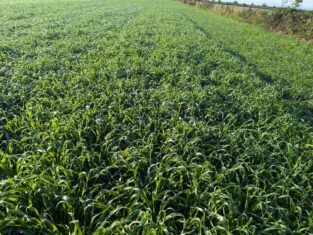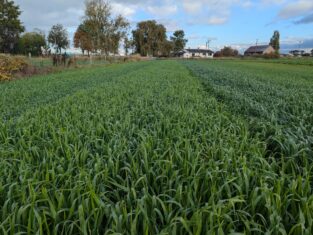Each fall, farmers across the lower mainland plant cover crops to enhance soil productivity and support wildlife. These crops play a crucial role in maintaining soil health, reducing soil erosion, improving nutrient cycling and providing food for migratory waterfowl. As cover cropping becomes a more common practice, there is more information and seed available for different types of cover crops. However, the effectiveness of cover crops depends on several factors, including weather conditions, planting dates, the specific species chosen, and the level of waterfowl pressure on the fields.

This year, the Delta Farmland and Wildlife Trust began an exciting initiative with our Cover Crop Variety Trial. The primary goal of this trial is to evaluate how 20 different cover crop varieties perform under local conditions, providing valuable insights for farmers looking to optimize their winter planting strategies.
The trial was conducted on Westham Island in Delta, where cover crops were seeded on two separate dates: August 29th and September 3rd. Throughout the growing season, we closely monitored each plot on a weekly basis, tracking important metrics such as percent coverage, vegetation height, and weed presence. We also monitored for any waterfowl grazing, though there was no damage recorded as of October 24th. During the trial, the total rainfall was approximately 203 mm. From August 29 to October 17, rainfall was consistent with the region's typical patterns. However, a heavy rain event from October 18 to 20 contributed an additional 112 mm to the field.

Rain gauge on October 24th
Our findings thus far have been promising. Among the various cover crop mixes, we observed that Oats, Barley, and the Late Pollinator Mix achieved the tallest plant heights.

Height of Tallest 10 Cover Crop Varieties Measured Weekly

Height of Shortest 10 Cover Crop Varieties Measured Weekly
Most cover crop mixes provided almost 100% soil cover. Though species such as Sun hemp and Sorghum did poorly in both vegetation height and cover, most likely due to being warm season crops.

Cover Crop species with higher percent cover

Cover crop species with lower percent cover
Looking ahead, our monitoring efforts will continue throughout the winter months. We aim to assess how well these cover crops withstand the colder temperatures and to evaluate their resilience against any waterfowl pressure that may arise. Understanding these dynamics will help us refine our recommendations for future cover crop planting, and ultimately better support farmers.
Stay tuned for updates!
To learn more about the species used in this trial as well as seeding information please view our variety trial handout.
To learn more about the BC Living Lab, visit www.bclivinglab.ca. This project is funded, in part, by Agriculture and Agri-Food Canada through the Agricultural Climate Solution; delivered by the Investment Agriculture Foundation of BC.




